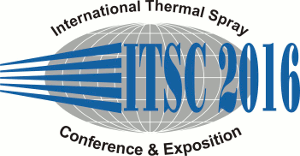
|
4863 |
|
Wednesday, May 11, 2016, Room 3G 2:20 PM Modeling & Simulation II |
|
Finite element simulation of the impact of cold sprayed metallic glass particles |
|
Giovanni Bolelli* / Department of Engineering "Enzo Ferrari", University of Modena and Reggio Emilia, Italy John Henao / Thermal Spray Centre (CPT), Universitat de Barcelona, Spain Amadeu Concustell/ Thermal Spray Centre (CPT), Universitat de Barcelona, Spain Irene Garcia Cano/ Thermal Spray Centre (CPT), Universitat de Barcelona, Spain Luca Lusvarghi/ Department of Engineering Enzo Ferrari , University of Modena and Reggio Emilia, Italy |
|
Metallic glass coatings can have unique wear and corrosion resistance properties, because of their non-crystalline structure. Cold spraying is a particularly suitable deposition techniques, as the low gas temperatures (compared to other thermal spray processes) prevents oxidation and crystallisation. The knowledge on the deposition of cold-sprayed polycrystalline metals, however, cannot be applied to metallic glasses, due to their peculiar mechanical behaviour. The impact of cold-sprayed metal glass particles onto various substrates (carbon steel, stainless steel, Inconel, aluminium and copper) was therefore simulated by the finite element method in this research, using the vitreloy-1 (Zr41.2Ti13.8Cu12.5Ni10Be22.5) composition as a case study, because its mechanical and thermal properties are well known from the literature. Different plasticity models were implemented, resulting in a good accordance between predicted particle deformation and previous experimental works. Simulations carried out at different initial temperatures and velocities indicate that particle deformation primarily depends on its Reynolds number (Re), a result that corroborates previous models and experimental observations. As Re increases, particle flattening is improved, but excessively high values (e10), corresponding to extremely high particle impact velocities and temperatures, result in the particle material overflowing the impact crater produced on the substrate, with the development of undesirable, non-bonded lateral extrusions. Localisations of temperature, stress and plastic deformation within the particle are revealed by the simulations, which correspond to experimentally visible shear bands. Strain and temperature maxima occur along the periphery of the impact area, whilst much less deformation is produced at the impact centre, where non-bonded regions were experimentally observed. The size of the impact crater on the substrate depends on its mechanical strength and on impact energy; however, plastic deformation of the substrate is highly localised next to the impact surface, which was confirmed experimentally by SEM observation of etched cross-sectional microstructures. |